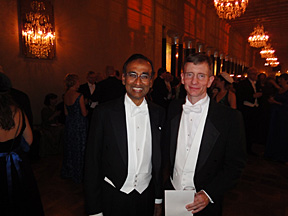Chemistry Alum Goes to Stockholm
When Brian Wimberly ’86 visited his former professor, Gary DeFotis, last year, he told him “I should thank you and the rest of theW&M chemistry faculty for creating my appetite for this sort of science.” Brian’s interest in chemistry has led him to a PhD, postdocs at Scripps Institute and at the University of Utah, jobs in the pharmaceutics industry and most recently return to academia. His work has taken him all over the continent and beyond.
Brian graduated from William and Mary in 1986 with a chemistry major and highest honors in his senior research. He began graduate school in Chemistry at Berkeley in 1986 but he was uncertain what he wanted to do. Fortunately, he ended up in Nacho Tinoco's lab where generations of eminent nucleic acid scientists had been spawned. Extremely little was known about the three-dimensional structure of RNA. With some assistance they began to make the relatively large amounts – milligrams – of small pieces of functionally important RNA for structural studies. Brian used multidimensional NMR methods to determine some of the first three-dimensional structures of several non-helical RNA motifs. His favorite large RNAs to use as inspiration for new projects were the three RNAs found in the ribosome.
All cells contain ribosomes. The ribosome is the polymerase (enzyme) that uses genetic instructions to link amino acids into proteins, and is critical in many respects. The large RNA content – from about one- to two-thirds – is the most remarkable feature. Ribosomes are unusually large enzymes, as large as 3.5 megadaltons for human ribosomes. For many reasons, the ribosome long embodied something of a “Mount Everest” of targets for structural biologists.
During a first postdoc at Scripps, and inspired partly by new crystal structures of RNA, Brian could see that improved crystallographic methods had the potential to have a huge impact on structural studies of ribosomes. He talked with Venki Ramakrishnan, a crystallographer who had determined structures of several small proteins that glue ribosomal RNA together. In early 1996 Brian’s job prospects looked bleak, so he visited Venki at the University of Utah, in Salt Lake City, who had implicitly offered him a postdoctoral position. During the visit Brian received an offer for an assistant professor position elsewhere. It was a difficult decision: an independent faculty position, or a riskier but possibly much higher-profile second postdoc to work on crystallography of ribosomes? He decided that the gamble was worth the risk.
Salt Lake City is beautiful but there wasn't much time
outside the lab. Brian never did learn to ski! But he did solve the first
crystal structure of a piece of ribosomal RNA bound to a ribosomal protein. More
importantly, Venki led the group’s charge on their crystallographic studies of
one of the two subunits of the ribosome. By early 1999 they were making rapid
progress and eventually Brian was able to trace one of the four domains of the
1500-nucleotide ribosomal RNA. By the fall of 2000 not only had they finished
the structure of the especially important 30S subunit of the ribosome but Tom
Stei tz and Peter Moore had also solved the structure of the large 50S ribosomal
subunit. These years (1998-2001) were an incredible experience and Brian feels
very fortunate to have had the opportunity to help in this work and to have
been first author on the main publication to emerge from their work contributing
to the Nobel Prize in Chemistry.
tz and Peter Moore had also solved the structure of the large 50S ribosomal
subunit. These years (1998-2001) were an incredible experience and Brian feels
very fortunate to have had the opportunity to help in this work and to have
been first author on the main publication to emerge from their work contributing
to the Nobel Prize in Chemistry.
In the fall of 2000 Brian was recruited to Pharmacia Corporation which merged later with Pfizer. He was able to continue structural studies of ribosomes, and also learned the difficult interdisciplinary business of drug discovery. A year later he was recruited to Rib-X Pharmaceuticals, a new Yale start-up company with the goal of discovering new antibacterials. In October 2009 the news came that Venki, Tom Steitz and Ada Yonath had been awarded the Nobel Prize in Chemistry. Brian was able to join them in Stockholm for the award ceremony. The week of festivities in Stockholm is a story in itself.
Brian spent almost ten years at Rib-X and he enjoyed his time there, but always felt somewhat out of place in a corporate environment. So late in 2011 Brian left Rib-X and has returned to academia at UC Denver.
 Skip to main content
Skip to main content
